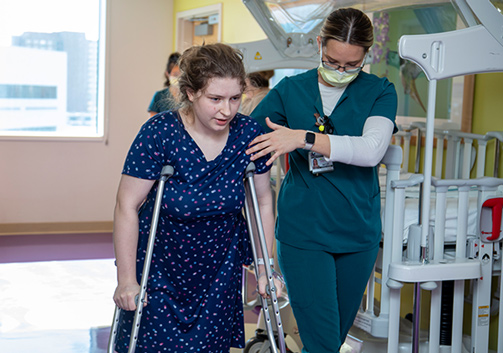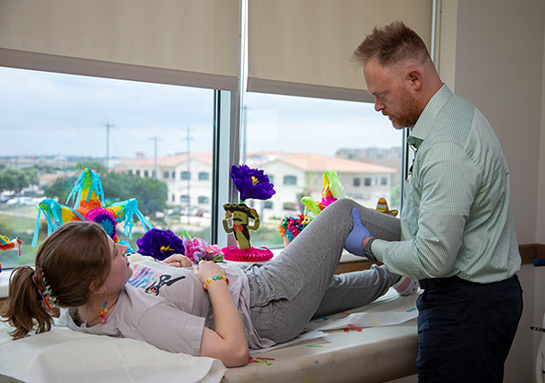Treating Hip Dysplasia with Periacetabular Osteotomy (PAO) Surgery
Havely’s Road to Recovery at CHRISTUS Children's
From early in her life, pain was all Havely ever knew. For years, she experienced intense pain in her knees and lower legs.
As a teenager, working as a cashier, she often came home crying in pain after standing up throughout her shift.
Havely and her parents tried every route to identify the issue: pediatricians’ offices, specialists, X-rays, MRIs, pain medication, more specialists and even reaching out to other families through social media support groups.
They tried it all and were met with uncertainties, confusion, and misdiagnoses. It’s the type of childhood no parent would wish on their child, but for the Thomas family, it was their reality.
It felt overwhelming, like we were constantly searching for answers but never finding them,
Havely’s mother said. Every new doctor, every new test brought a glimmer of hope, only to be let down again. We felt like we were in a constant state of searching and worrying.
That is until they met Tyler Stavinoha, MD, an orthopedic surgeon at CHRISTUS Children's, whose expertise in treating hip dysplasia in children and adults proved to be the answer they had been seeking for so long. After meeting him for the first time, they began to feel hope.
Living with chronic pain is exhausting, not just physically but also mentally,
said Havely, now a senior in high school. After years of pain and confusion, I could finally begin to imagine a future without pain.
Early Childhood Struggles with Leg Pain
Havely vividly recalls her early battles with pain from, what she later found out, was hip dysplasia.
When I was really little, the pain in my lower legs was so intense that I’d have to army crawl down the stairs after my knees would lock up overnight.
Despite numerous medical exams, her pain was repeatedly dismissed as "growing pains." The family tried various remedies, including calcium and potassium supplements and extensive physical therapy, but nothing alleviated her suffering.
As she grew, the pain increased every few months. Alarmed, Havely and her parents knew they had to find a new solution fast.
Tests and Misdiagnoses
Havely soon underwent four MRIs, and she was initially diagnosed with ischiofemoral impingement – a condition typically seen in elderly patients with total hip replacements.
I remember thinking that was impossible. There’s no way I could have that,
Havely said.
Further tests, including blood work, led doctors to advise her to reduce her pain medication intake due to its effects on her other organs. Despite these efforts, her condition remained a mystery, causing confusion about whether it was arthritis, Lyme disease or something else.
The persistent pain and uncertainty also affected Havely’s mental health, leading to significant stress and anxiety. She spent three years in physical therapy without even knowing what condition she had, making it difficult to manage both her physical and mental health.
Frustrated by the lack of answers, the Thomas family consulted a different local pediatrician who ordered extensive imaging and consulted with various specialists. This approach eventually led them to Dr. Stavinoha at CHRISTUS Children's.
CHRISTUS Children’s Orthopedic Specialist Provides Clarity
Dr. Stavinoha's expertise and demeanor provided the clarity and direction the family had long sought.
It felt like he was the first doctor who really listened and was determined to figure it out,
Havely said.
Dr. Stavinoha’s evaluation revealed the severity of her condition and the necessity for surgery. At long last, Havely and her parents found out she had hip dysplasia and needed a periacetabular osteotomy (PAO) procedure.
Understanding Pediatric Hip Dysplasia and Periacetabular Osteotomy Surgery
What is hip dysplasia?
- Hip dysplasia is a condition where the hip socket does not fully cover the ball portion of the upper thigh bone, leading to increased wear and tear on the joint, pain and potential arthritis.
- It can be present at birth or develop during childhood or adolescence.
- Typical symptoms include a slow onset of pain in the hips, groin, thighs or even knees.
What are the risk factors associated with pediatric hip dysplasia?
- Hip dysplasia is about twice as common in females.
- Can be a genetic condition passed on to children from their biological parents.
What is periacetabular osteotomy?
- PAO is a surgical procedure to treat hip dysplasia by reorienting the hip socket to provide better coverage and preserve the cartilage.
- The procedure involves making precise cuts around the hip socket through a single incision near the pelvis. After reorientation, the joint is stabilized with screws, allowing healing and full remodeling of the bone.
- After surgery, no cast is used. Patients are typically allowed to bear
Surgery for Childhood Hip Dysplasia
Dr. Stavinoha’s confirmation of Havely's condition and recommendation for surgery brought both relief and anxiety to the Thomas family.
I was terrified of needles and the thought of surgery,
Havely admitted. However, the compassionate care from the CHRISTUS Children's team made all the difference. From the nurses' encouragement to the anesthesiologist's calming presence, each interaction helped ease my fears. Everyone treated me like a person, not just a patient,
she said.
The surgery, performed in the spring of 2024, was a pivotal moment for Havely and her family.
The periacetabular osteotomy procedure improves joint stability and distributes
the load more evenly across the hip joint,
said Dr. Stavinoha. By maintaining the integrity of the surrounding muscles and neurovascular structures, we can significantly reduce recovery time and enhance postoperative outcomes. For Havely, our goal was to significantly reduce both postoperative pain and the long-term pain she had been experiencing for so long.
Havely’s parents vividly recall the tense moments in the waiting room during the procedure. When Dr. Stavinoha finally came out of the OR, his reassuring words to her waiting family were a lifeline: She’s great. Everything went well.
The Impacts of Therapy Dogs
Post-surgery, Havely's recovery was inspiring. She quickly understood the difference between chronic pain and the temporary pain from surgery.
A crucial part of her healing journey was the arrival of Jaime, a facility dog who is part of the CHRISTUS Children's child life program. Jaime’s presence brought immense joy and comfort to Havely, significantly aiding her recovery. Hanging out with Jaime was one of the best feelings I’ve ever had. It helped me recover faster than I think I could’ve without him. It gave me motivation,
she said.
Interestingly, her parents observed a drop in her heart rate while she was petting Jaime. This calming influence not only helped Havely manage her pain but also provided emotional support during a challenging time. The bond she formed with Jaime was a source of constant positivity, making her hospital stay more bearable and her recovery quicker.
Recovery from PAO Surgery
Within days, Havely was up and moving with crutches, managing her pain effectively. The dedicated team at CHRISTUS Children’s, including physical therapists and nutritionists, provided holistic support crucial to her swift recovery.
Recovery from PAO surgery typically involves physical therapy to restore strength and mobility. Patients like Havely work closely with physical therapists to gradually increase their activity levels, focusing on exercises that enhance flexibility, build muscle strength and improve overall joint function. This comprehensive rehabilitation process is crucial to ensure a successful outcome and help patients return to their normal activities pain-free.
Havely's road to recovery continues, with plans for a second surgery in the fall of 2024 to address her other hip. Her outlook is bright as she eagerly anticipates getting to enjoy the things she loves, but now with no pain to hold her back. I can't wait to cook my favorite Korean meals, return to work, walk across the stage at graduation without a limp and dance at the Justin Timberlake concert,
she shared with excitement.
Havely's story highlights the importance of expert medical care, family advocacy and childhood resilience.
My biggest advice to other kids in this situation is to advocate for yourself. Nobody understands your pain as much as you do, and you have to speak up for yourself. Thankfully, my parents and Dr. Stavinoha helped me finally find the answers I so desperately needed.
At CHRISTUS Children’s, every child’s journey is met with professional expertise, compassion and hope. Click here to learn more about hip dysplasia and the innovative orthopedic surgery treatments available to children and young adults with symptoms like Havely’s.




